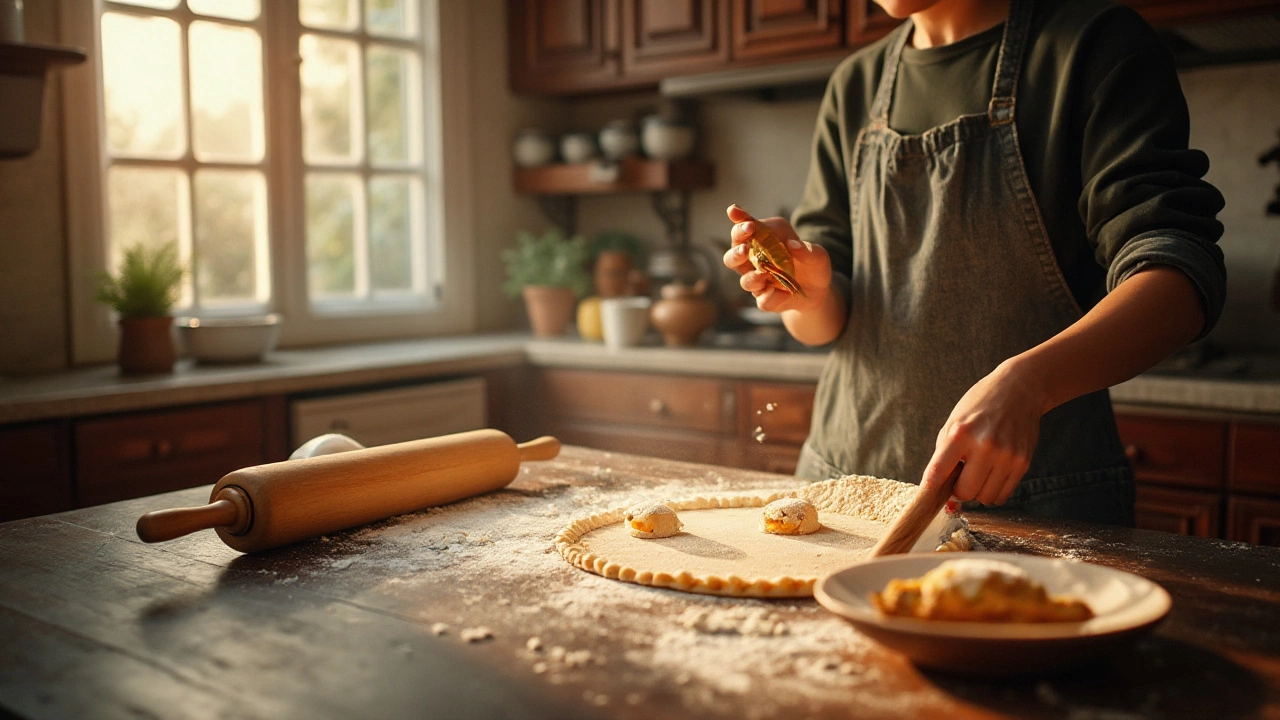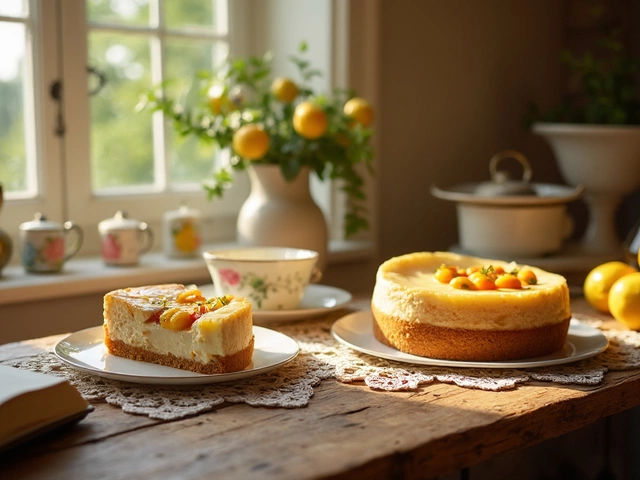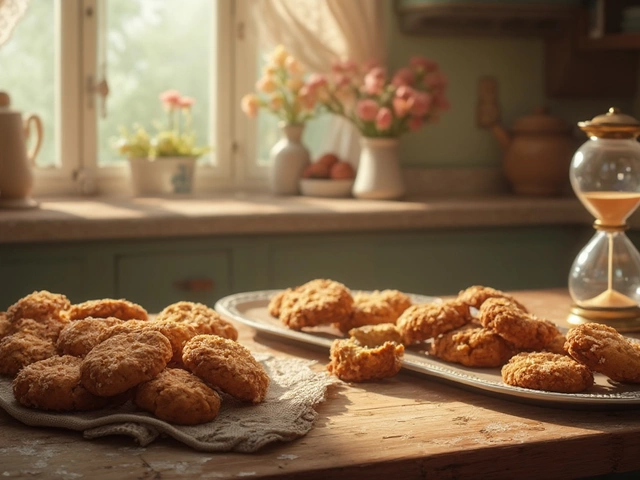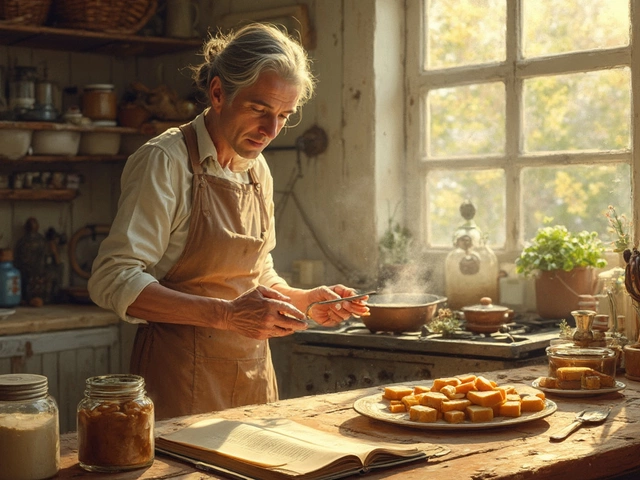The 'Wife Cake,' a name that instantly sparks curiosity, is a pastry that combines tradition, love, and taste in a single bite. Originating from Cantonese cuisine, this pastry resonates with a romantic legend that has been passed down through generations. While its true origin may be shrouded in mystery, the delightful winter melon filling and crispy layers are sure to captivate anyone who takes a bite. In this article, we'll not only explore the enchanting story behind this quaintly named dessert but also delve into its cultural significance and guide you in making your own Wife Cake at home.
For those intrigued by culinary stories or seeking a new recipe challenge, the Wife Cake offers both a historical journey and a baking adventure. Prepare to immerse yourself in an age-old Chinese cultural experience that speaks the language of love and devotion, all wrapped in a deliciously flaky crust.
- The Tale Behind the Name
- Cultural Significance of Wife Cake
- Ingredients and Preparation
- Step-by-Step Baking Guide
- Tips for Perfecting Your Wife Cake
- Enjoying and Sharing Your Creations
The Tale Behind the Name
The enigmatic origin of the Wife Cake, also known as 'Lou Po Beng' in Cantonese, is steeped in a story as sweet as its luscious filling. Legend has it that the tale began in the heart of China, during a time when modest families faced significant hardships. A loving wife, determined to aid her ailing husband's impoverished family, crafted a pastry so delightful that it captured the heart and taste buds of the local villagers. Her resourcefulness in including simple yet flavorful ingredients turned the Wife Cake into a coveted commodity, thus ensuring the family's financial stability. Some say the winter melon filling was chosen for its accessibility and affordability back then, making it a common household ingredient that could easily be transformed into something magical under her skilled touch.
The romantic narrative doesn't end with mere financial success. The true essence of the tale lies in the unyielding bond between the couple, a testament to the power of love and sacrifice. This touching story is so embedded in the fibers of the Chinese pastry tradition that it continues to inspire new generations to this day. It's the tale’s warmth and humanity that give this humble dessert its enduring appeal. While there are variations to the story, the central theme remains the same: deep love and selflessness. A certain article in the Culinary Chronicler remarks how "food has always been a love language, transcending cultures and time with its ability to convey emotions and stories".
Such stories, they argue, infuse recipes with the richness of human experience, making every bite of a Wife Cake a step back in time.
Beyond the anecdotal charm, the Wife Cake holds significant cultural relevance. In many households, it is traditionally served during festivals and celebratory occasions, where its flaky and sweet character provides a metaphorical sweetness to gatherings. As you bite into one, you might not only savor the finely kneaded dough and delicate layers of pastry but also the enduring narrative of devotion that serves as its foundation. This story, so delicately woven with history, illustrates how culinary efforts can be a testament of personal relationships and cultural identity. It's these elements that transform the dessert from a mere food item into a cherished symbol of legacy and love.
Cultural Significance of Wife Cake
Embedded in the rich tapestry of Chinese culinary tradition, the Wife Cake, also known as 'Lo Po Beng', holds a special place in the hearts of many, especially in Cantonese regions. This pastry is more than just a dessert; it represents a poignant tale of love and loyalty that resonates deeply within Chinese culture. The origins of its name are rooted in a heartwarming story about a dutiful wife who selflessly sold herself into slavery to support her husband's ailing father. Touched by her profound love, her husband created the Wife Cake, symbolizing devotion and sacrifice, which appealed to the locals and eventually became an integral part of their culinary heritage.
The Wife Cake's cultural resonance extends beyond its narrative roots, as it has become a staple in Chinese festivities and familial gatherings. During the Mid-Autumn Festival, a time of familial reunion and harmony, these cakes are often gifted and shared among family members, strengthening bonds and fostering a sense of community. It's not just the sweetness of its filling that endears it to many, but the very sentiment it embodies. In many Cantonese weddings, these cakes also feature as part of pastry assortments, symbolizing sweet marital bonds and auspicious beginnings. As Dr. Wei Ming, a culinary historian, explains,
"The Wife Cake is a metaphor for Chinese values — love, resilience, and unity. Its presence at family celebrations ties us to our past and encourages future generations to honor these timeless principles."
Beyond this poetic narrative, the Wife Cake also reflects the innovative spirit and resourcefulness of Cantonese bakers. Despite its simple ingredients — winter melon, almond paste, and sesame seeds — it's a testament to how traditional Chinese desserts are crafted with precision to achieve layers of flavor and texture. This pastry has also found its way internationally, showcasing how global appreciation for authentic Chinese delicacies has surged over the years. As more people discover the captivating tale and taste behind the Wife Cake, it continues to bridge cultural gaps, inviting intrigue and admiration across continents. Its cultural significance can be observed not only in China but also in overseas communities where traditions from the homeland are lovingly preserved through food. Exploring why people continue to cherish the Wife Cake reveals much about the enduring bond between food and culture, highlighting how each bite takes you through a journey rich in history and emotion.
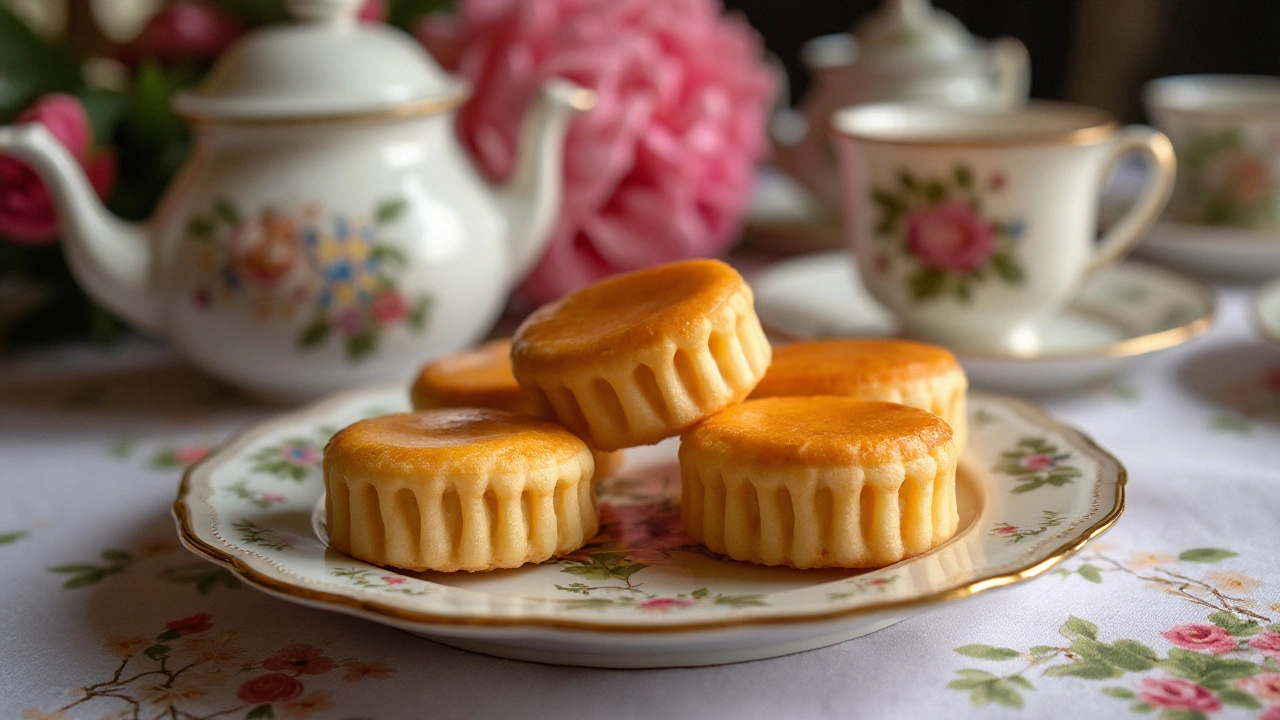
Ingredients and Preparation
The art of making a Wife Cake, known for its unique combination of rich flavors and delicate textures, begins with gathering the perfect ingredients. Understanding the composition of this classic Cantonese dessert is key to bringing its traditional taste to life in your kitchen. Historically, Wife Cake recipes have been handed down through generations, with subtle regional variations that illustrate the diverse tapestry of Chinese baking. To create this pastry, you'll need to assemble both the water dough and the oil dough, which contribute to its characteristic flaky crust, as well as the distinctive sweet filling, often featuring winter melon as the main ingredient.
Start by preparing the water dough using all-purpose flour, a touch of sugar, and a pinch of salt, combined with water and a bit of lard for richness. Separately, the oil dough, crafted by mixing flour with more lard, contributes to the luxurious mouthfeel that is key to the Sweetheart Cake's allure. When blended, these two doughs will provide layers that are crisp yet tender—a hallmark of good pastry. The filling, a sweet concoction made primarily of cooked winter melon, combines with sugar, glutinous rice flour, and desiccated coconut, providing a texture that beautifully complements the pastry. Occasionally, sesame seeds and almond bits add crunch and a nutty depth that's unmistakable.
As
Chef Ming Lee of Hong Kong's renowned pastry shop once said, "The secret to an exceptional Wife Cake lies in balancing the subtle sweetness of the filling with the light flakiness of the crust."With a nod to tradition, many chefs also incorporate unconventional ingredients like dried osmanthus flowers or even pandan leaves to impart a fragrance that dances across the senses, enhancing the overall eating experience. These innovative twists on classic recipes are a testament to the ever-evolving nature of this cherished dessert, ensuring that each bite is steeped in history while leaving room for personal flair.
To begin, carefully measure and prep each ingredient, as precision is essential in pastry-making to achieve the desired consistency and flavor profile. For those who are meticulous, creating an ingredient table can streamline your process:
| Ingredient | Quantity |
|---|---|
| All-purpose Flour | 200g |
| Lard | 50g |
| Sugar | 60g |
| Winter Melon | 300g |
Once you've gathered and measured all components, the preparation demands your attention to detail and patience, as mastering the technique of blending the two doughs requires finesse. Roll and fold these layers with care, ensuring they remain thin and cohesive, which is key to achieving the pastry's storied lightness. As the dough rests, seize the opportunity to concoct a silky filling rich with the subtly sweet flavor of winter melon, enhanced by the occasional addition of a pinch of salt to counterbalance the sweetness.
Ultimately, crafting Wife Cake is not merely a matter of following a recipe but a dance of flavors and textures, requiring an understanding of the ingredients' interplay. It invites cooks to step into the realm of tradition, a nod to familial heritage embedded in every fold, sweetened layer by layer. As you move forward with the recipe, bear in mind that each step is not just a task but a tribute, encapsulating the ingenuity and love passed down throughout the ages. Allow the creation of Wife Cake to elevate your baking repertoire and bring a slice of cultural history to your table.
Step-by-Step Baking Guide
The journey of crafting the perfect Wife Cake is as rewarding as its taste. To start this adventure, gather the essential ingredients which give the pastry its unique flavor. You'll need winter melon, which is the star filling, along with sugar, glutinous rice flour, and desiccated coconut for texture and taste. The dough requires flour, sugar, shortening, butter, and water to achieve that signature flaky texture. With everything assembled, you're ready to create a masterpiece that is both art and tradition encased in pastry.
Begin with preparing the winter melon filling by grating and squeezing out excess moisture from the winter melon. Cook it on a low flame with the sugar until the mixture thickens, stirring occasionally to prevent sticking. Add glutinous rice flour gradually, allowing it to combine thoroughly with the melon, creating a smooth, thick consistency. Finally, mix in the desiccated coconut and allow the mixture to cool down. This filling is not only sweet and aromatic but resonates the traditional essence of Chinese pastry.
While the filling cools, you can shift your attention to making the dough. The traditional method of creating the pastry involves making two types of dough: a water dough and an oily dough. Start with the water dough by combining flour, sugar, and water into a smooth, elastic ball. For the oily dough, blend flour with shortening until the mixture resembles soft breadcrumbs. Rest both doughs for at least 30 minutes under a damp cloth. Resting is crucial to let the gluten develop, ensuring your pastry turns out as flaky as a freshly fallen autumn leaf.
Once the doughs are ready, create small balls of the oily dough, which will be wrapped by the water dough. The wrapping process is delicate, requiring patience and practice. Roll both doughs separately into thin sheets and envelop the oily dough within the water dough. Roll this doubled-layered dough sheet flat, then fold it into thirds and repeat the rolling process to build layers. The technique may take some getting used to, but the result—a wonderfully layered and flaky pastry—is worth every effort.
Cut the layered dough into even pieces, each to encase spoonfuls of the cooled winter melon filling. Shape them into rounds and flatten them slightly, making sure they retain the filling securely. Preheat your oven to 180°C (356°F) during this time. Arrange the cakes on a baking tray lined with parchment paper, brushing the tops with an egg wash for a glossy finish. Bake the Wife Cakes for about 20-25 minutes or until golden brown and crisp. Keep a watchful eye to avoid over-baking, as the delicate crust is prone to quick burn.
"Cooking is at once child's play and adult joy. And cooking done with care is an act of love." – Craig Claiborne
Let the cakes cool for a bit before serving—if you can resist the urge. As you take a bite, savor the contrasting textures; the crisp exteriors giving way to a soft, sweet, and slightly chewy filling. Whether you're baking for your loved ones or indulging solo, this Cantonese dessert makes for a perfect fusion of taste and tradition. Not only does baking Wife Cake connect you with a rich cultural past, but it also fills your home with the warm aroma of shared love and history.
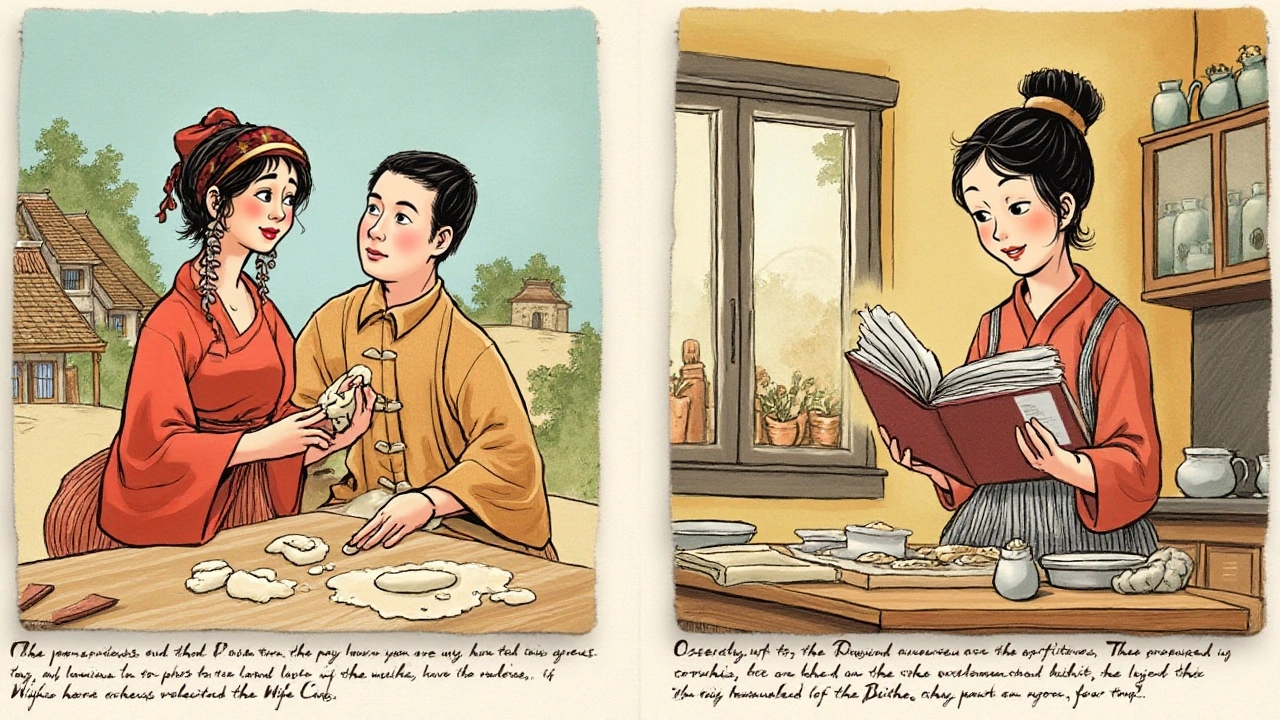
Tips for Perfecting Your Wife Cake
Creating an impeccable Wife Cake requires attention to detail in every aspect, from dough preparation to final presentation. Firstly, the type of flour you choose can have a significant effect on the texture of your Chinese pastry. It's recommended to use pastry flour instead of all-purpose flour, as it contains less protein and provides a finer texture, which is perfect for those flaky, tender layers that make the Wife Cake so delightful. Mixing the dough enough to bind ingredients without overworking it is essential to avoid a tough crust. Each step of handling the dough calls for a careful balance – gentle yet precise motions ensure the desired outcome.
Temperature plays a crucial role in both dough and filling. Keeping the dough cool while working with it ensures it remains pliable and avoids becoming overly greasy, which can occur if the butter in the dough starts to melt prematurely. Similarly, when preparing the sweet winter melon filling, be sure to allow it to cool entirely before assembling the pastries. A warm filling will cause the dough to become too soft and difficult to roll out properly.
Another secret to achieving the perfect Cantonese dessert is patience during the baking. Always preheat your oven to the right temperature before placing the pastries inside. During baking, place the pastries on a middle rack for even heat distribution. This placement helps to achieve a beautifully golden crust without burning, while ensuring the filling is gently heated to its luscious, sweet final form. Baking is an art that thrives on time and precision, so pay close attention during these final stages.
Don't underestimate the presentation aspect of these charming treats, especially since their unique shape and color are part of their allure. Before baking, brushing each cake with an egg wash provides a warm, golden hue, adding not only to the visual appeal but also contributing to a delightful crispness as you bite into the wife cake. Some bakers recommend gently scoring the top of the pastries to allow for steam release, which also adds a decorative touch. A touch of sesame seeds can be sprinkled over the top for an authentic finish and added texture.
According to food historian Rachel Laudan, "Pastry-making is not just about skill; it’s about understanding the harmonious blend of ingredients and patience; that’s what creates magic in baking."
Here is a helpful table with temperature guidelines for baking different types of pastries, including our beloved Wife Cake:
| Pastry Type | Ideal Baking Temperature | Baking Time |
|---|---|---|
| Sugar Cookies | 350°F (175°C) | 8-12 minutes |
| Croissants | 375°F (190°C) | 20-25 minutes |
| Wife Cake | 375°F (190°C) | 25-30 minutes |
By understanding these intricacies and embracing the patient art of baking, you can bring out the best in this timeless cake recipe and enjoy every flaky, sweet moment of its delightful flavor.
Enjoying and Sharing Your Creations
Baking a Wife Cake is just one part of the journey; savoring and sharing this gem of a pastry brings its own set of joys. Once you've baked the perfect batch, the first bite is a revelation—a harmony of sweet and savory, marked by the delicate balance between the flaky crust and the luscious winter melon filling. The golden brown exterior crumbles delicately as you bite into it, releasing a satisfying combination of textures and flavors that make Wife Cake a beloved treat within Cantonese cuisine. It’s tempting to keep them all to yourself, but these cakes were made to be shared, reflecting the story of love and care from which they derive their name.
As you savor each bite, remember that the Wife Cake has a symbolic cultural significance that makes it more than just a dessert. Consider hosting a small gathering with friends and family, offering them a taste of Asia’s intriguing culinary customs. If you're passionate about the stories behind your dishes, this is a perfect platform to share the tale of the Wife Cake. Artfully displayed on a platter, these treats can be the centerpiece of any dessert table, fostering conversation and connection. And what a rewarding experience it is to watch others enjoy something that you have crafted with your own hands, deepening bonds and creating new memories with every piece shared.
"Sharing food with another human being is an intimate act that should not be indulged in lightly." – M.F.K. Fisher
If you are looking to gift Wife Cakes, present them in an elegant box or a traditional Chinese tin. This not only keeps the cakes fresh but adds a touch of authenticity. When giving them as a gift, explain their cultural history to the recipient; it will make the offering even more special. You might also want to pair these delectable pastries with some premium Chinese tea. Create a small card with a brief explanation of why these cakes are meaningful and a mention of your favorite part about baking them, which adds a personal and heartfelt touch. These thoughtful gestures of sharing go beyond the simple act of giving food—they extend the story and cultural significance to others, enhancing their appreciation of this time-honored treat.
For those with a culinary blog or an active social media presence, sharing your Wife Cake creations offers an opportunity to connect with a wider audience. Use platforms like Instagram or Pinterest to show off your beautifully baked cakes. Be sure to include a story or a snippet about the history behind them or the process you went through while baking. Engaging content often sparks conversations and brings increased interest, which might lead others to try baking them at home, thereby keeping the tradition alive. Using hashtags like #WifeCake or #CantoneseDessert can attract fellow food enthusiasts who share your passion. The joy of baking is amplified when shared with an enthusiastic community, where each person brings their own perspective and twist to this classic pastry.

